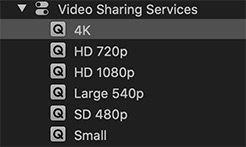Tip #458: Video Compression Settings for YouTube
… for Codecs & Media
Tip #458: Video Compression Settings for YouTube
Larry Jordan – LarryJordan.com
Compensate during compression for social media recompressing your files by adjusting bit rates.


YouTube, and other social media services, always recompress your data. This is necessary to support all the different playback devices, software and codecs in the real world.
If you send YouTube a perfectly compressed file, it will still recompress it – because it has to convert it to all these different codecs. In doing so, because there is not enough data, it will damage the quality of your audio. To prevent this, we need to create a “mezzanine,” or middle, compression file so that when YouTube recompresses the file it has some bits it can throw away. H.264 is an excellent choice for this intermedia codec, provided you use a high-bit rate. Higher bit rates won’t hurt, they’ll just create larger files which will take longer to transfer.
NOTE: Both Apple Compressor and Adobe Media Encoder have default compression settings for social media. In most cases, their defaults should be fine.
Here are the settings:
| Compressed Frame Size | Bit Rate |
|---|---|
| 720p | At least 10,000 kbps / 10 mbps |
| 1080p | At least 15,000 kbps / 15 mbps |
| 4K | At least 20,000 kbps / 20 mbps |
NOTE: These settings work for all frame rates up to 60 fps.
EXTRA CREDIT
Tip #455 explains audio compression settings for YouTube


Any thoughts on using h265?
Jim:
H.265 (HEVC) is a great distribution codec, but it has limited value to media creators. It’s claim to fame is smaller files with the same image quality as H.264. But, since YouTube et al recompress our media, sending an H.265 file to YouTube doesn’t benefit us much. H.265 takes much longer to compress. My sense is for anything going to social media, which will be recompressed, stay with H.264.
Larry
Great content! Super high-quality! Keep it up! 🙂